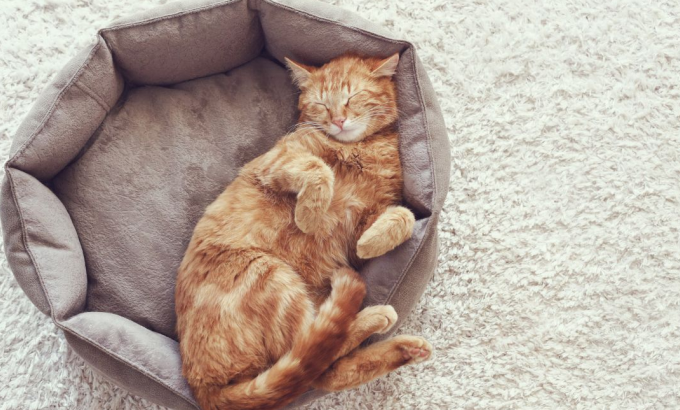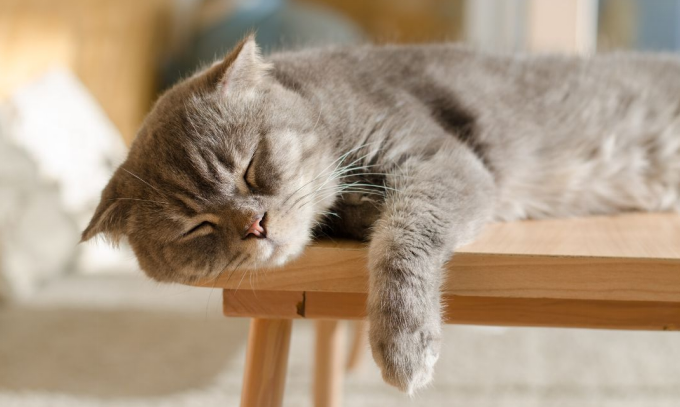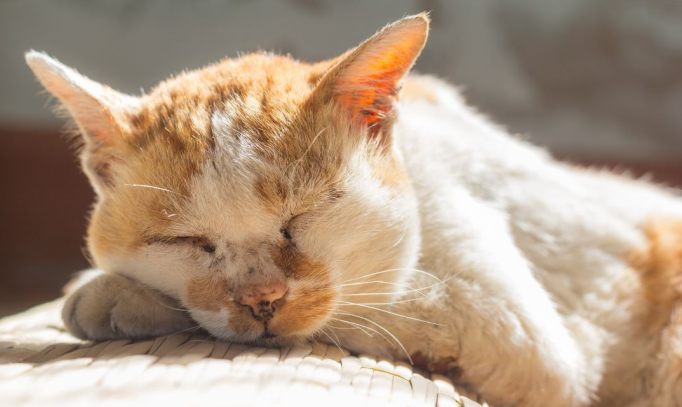Cat Sleeps All Day? Here's What That Really Means

Some cats? Barely move. Eat a little. Sleep a lot. Shift sides like clockwork. Then right back to sleep. But here’s where it gets weird—how much is too much? That line between rest and red flag? Not obvious. It's quieter than you'd think. Missable, until something shifts. That's what makes this worth digging into.
Could be nothing. It could be subtle. You won’t know unless you see the full picture—and that’s what this gives you. Less guesswork. More clarity. Real signals. Not overreactions.
We’re covering:
● What a normal sleep cycle actually looks like
● Why do some cats hit the snooze button more than others
● How things like age, breed, and household rhythm quietly shape their patterns
● What signs to watch for—and when it’s time to act
This isn’t about worry. It’s about watching with purpose.
How Much Sleep Is Normal for Cats, Really
We all know cats sleep a lot. No one’s shocked by that. But how much sleep is actually expected? That’s the messy part. No single number works for everyone.
Most adult cats spend somewhere between 12 and 16 hours a day. Sometimes more. A lazy-looking 20-hour nap session? Not rare—especially with age, boredom, or cold floors. But these aren’t random numbers. Sleep follows a rhythm. Built-in. Influenced by biology, light, mood, and routine.
Cats aren’t lazy—they’re crepuscular. Hunt at dawn. Linger at dusk. Middle of the day? Recovery time. That pattern’s baked in. Wild instincts don’t leave easily.
But sleep isn’t just sleep. A bunch of naps doesn’t equal good rest. Deep REM cycles do the heavy lifting. Healing, immune resets, memory—all tied to deeper phases. If your cat’s sleeping too still, too long, without variation, something may be off in that cycle.
Long naps? Not always a concern. Context matters more. Quality over quantity. Always.
Why Some Cats Log More Hours Than Others

You’ve seen it—some cats sprint laps at midnight. Others sleep so long that it looks clinical. That’s not by chance.
Here’s what stacks the hours:
● Age tilts the scale. Kittens run hot, then crash hard. Their bodies grow while they’re asleep. Older cats? Different story. Slower systems, longer recovery windows. They need more rest to stay even.
● Activity (or the lack of it). Cramped space, no toys, no play triggers? Naps fill the gap. On the flip side, high-activity cats actually sleep longer, but it’s earned. That sleep resets their engine.
● Subtle health issues. Obesity. Pain. Hidden inflammation. These quietly stretch rest periods. The cat isn’t lazy—it’s conserving.
● Food rhythm. Energy drops if feeding times are inconsistent or the food quality tanks. Sleep becomes the fallback.
● Temperament is baked into genetics. Laid-back breeds don’t chase shadows. They rest by design. That personality shift often tracks with longer sleep blocks.
All of these can show up alone or pile on. The trick? Knowing when extra sleep crosses into something else.
Age, Breed, and Routine All Shift Sleep Patterns
Sleep doesn't live in isolation. It reflects everything your cat is—genetics, hormones, movement, and history. Think of it like a readout. You just need to know how to interpret it.
Age and the Biological Sleep Curve
Start from birth. Sleep is the first language. Here’s how it evolves.
● 0–3 months: The body builds from the inside out. REM sleep runs the show. It wires the brain, immune system, and even sensory maps. It’s noisy sleep—twitches, squeaks, micro-movements. Up to 90% of the day is spent under.
● 4–6 months: Still heavy sleepers—up to 20 hours—but now they’re syncing with light cues. The rhythm stabilizes, though not perfectly. Hormones disrupt rest, and exploration competes with recovery.
● 7 months–2 years: Activity and sleep fight it out. Energy surges lead to longer crashes. Sleep tapers to the adult range but remains flexible. Any change in diet or environment shows up in their rest cycles almost immediately.
● 3–7 years: Predictability kicks in. Most healthy adults settle into blocks of sleep with non-REM stretches that cluster around daylight. Feeding and play schedules lock that rhythm into place.
● 8+ years: Aging shifts the pace again. Fatigue rises. Recovery takes longer. You’ll see sleep jump back toward 18 hours, but lighter. Arthritis, stiffness, even early brain fog (yes, that’s a thing) creep in. Sleep isn’t always restful anymore.
Old cats don’t just sleep more. They start using sleep to avoid discomfort. That’s the pivot point to watch.
Breed-Specific Sleep Tendencies
Some cats were practically built for the couch. Others are wired for chaos. Genes decide a lot of that.
● Persians: Built low and slow. They nap through most of their day—and for good reason. Shorter noses, respiratory inefficiency, and reduced stamina mean their energy curve is short. Long naps aren’t optional; they’re structural.
● Ragdolls: Big, gentle, people-oriented. They’re relaxed to a fault. Their drive to move is minimal unless something demands it. Eighteen hours? Not rare.
● British Shorthairs: Calm. Consistent. Efficient with their energy. In warmer months, that plush coat slows them down further.
● Bengals and Abyssinians: Total opposite. Built for chase, stalk, leap. They don’t rest easily unless they’re engaged first. If they nap all day, it’s not normal—it’s boredom wearing a sleep mask.
Don’t treat breed like trivia. It tells you where normal starts—and where you should start watching.
Routine and Environmental Sleep Modulation
Cats are synchronized creatures. They respond to signals most people don’t even register. Mess with those signals, and sleep is the first thing to change.
● Feeding cycles: Regular timing stabilizes the stress response. Irregular meals? Sleep turns foggy, fragmented. Sleep inertia kicks in hard.
● Stimulation (or absence of it): Cats burn through attention like fuel. No climbing, chasing, or hunting cues? They shut down. Nap out of boredom.
● Light, noise, chaos: Artificial light overnight. Blackout curtains during peak daylight. Loud TVs. Guests. It all throws off melatonin production. That hormone governs their sleep clock. Break it, and their rhythm collapses.
● Your routine: If your day’s unpredictable, so is theirs. Cats mirror their people—wake when you do, adjust when you adjust. Rotating shifts, late-night work, erratic wake times? It trickles into their rest.
These aren’t soft details. They’re structural. You fix sleep by fixing structure. Not the other way around.
Spot the Shift Before It Turns Into a Problem

Some cats really do sleep all day. But when that turns from rest into retreat, it stops being harmless.
● Behavioral Drift: Watch for the switch. Morning zoomies gone? Movement turns slow? Constant sleep in odd spots? That's not a lazy phase. It's a recalibration. Often silent. Sometimes pain-related. Track sleep over several days. Look for a baseline. Then look for breaks in that baseline.
● Emotional Cut-Offs: A cat that stops checking in with you? That’s a mood shift. Not always dramatic, but it counts. Long isolations, no greeting, pulling away from contact—these are passive s. They signal something deeper.
● Skipped Meals or Interrupted Feeding: Cats don’t skip food unless there’s a problem. When sleep swallows feeding windows, you're on a timeline. Missing even one or two meals—especially in kittens or seniors—can tip the balance. Smart feeders close that gap. The WOpet Heritage View Automatic Pet Feeder handles that angle for you. Portion control, schedule adherence, video checks—without being in the room. It's less about convenience, more about control when the pattern breaks.
● Movement Changes: Watch how your cat gets up. Stiff joints. Slower steps. Trouble jumping onto surfaces they used to reach easily? That’s joint feedback. Sleep increases when movement hurts.
● Red Flag Signals: You’ll want a vet on standby if sleep changes come with:
○ Noticeable weight shift
○ Labored breathing while resting
○ Twitchy sleep with vocalizations
○ Head butting into hard objects
○ Confusion, missed litter box trips
○ Drastic pupil shifts in daylight
When sleep becomes the place they hide—not the place they heal—you’ve crossed into clinical territory.
Cat Sleeps All Day? Get Smart About What It Means
Now, you're not wondering. You’re watching. On purpose. With structure. Sleep is no longer a shrug. It’s a signal. You know what normal looks like—for your cat, at this stage, with those genetics and that routine.
What does that mean going forward?
● You’ll spot shifts early.
● You’ll maintain consistency—even on days you’re away.
● You’ll respond before the small things escalate.
● You’ll give your cat autonomy without losing visibility.
That’s where tools like the WOpet Pioneer Plus Feeder with Camera make a difference. They keep the routine alive. They offer sightlines when you’re not home. They catch what your schedule might miss. Your cat might still sleep all day. But now? That doesn’t leave you in the dark.
source: https://wopet.com/cats/cat-sleeps-all-day/
![Automatic Pet Feeder with Camera [Dual Bowls] Automatic Pet Feeder with Camera [Dual Bowls]](https://wopet.com/uploads/admin/image/20250607/6c267b1c5bcd4b67d213724d1ecb0455.jpg)
Comments
Post a Comment